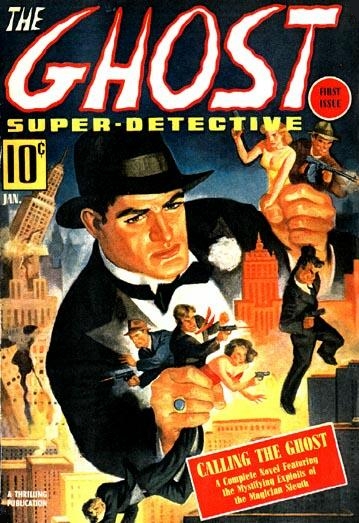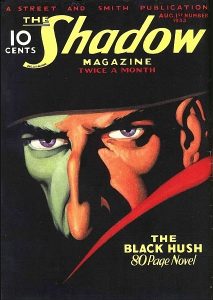 In the spring of 1931, THE SHADOW MAGAZINE was introduced to readers by Street & Smith Publications and proved an instant hit. Within a few short years, all of the leading pulp magazine publishers hoped to emulate its success by introducing their own hero pulps. The first to the starting gate would be Ned Pines’ Standard Magazines, the pulp chain that will be feted at this year’s PulpFest in Columbus, Ohio.
In the spring of 1931, THE SHADOW MAGAZINE was introduced to readers by Street & Smith Publications and proved an instant hit. Within a few short years, all of the leading pulp magazine publishers hoped to emulate its success by introducing their own hero pulps. The first to the starting gate would be Ned Pines’ Standard Magazines, the pulp chain that will be feted at this year’s PulpFest in Columbus, Ohio.
The first of the so-called hero pulps inspired by Walter Gibson’s “Dark Avenger” was THE PHANTOM DETECTIVE, launched in early 1933. Later that same year, Standard followed with the first air war hero magazine, THE LONE EAGLE. Next came G-MEN, the first pulp magazine to capitalize on growing popularity of J. Edgar Hoover’s FBI agents. Thrilling closed the thirties by introducing the heroic adventures of the Black Bat to readers of BLACK BOOK DETECTIVE MAGAZINE, a pulp that had been around nearly as long as the company’s first hero pulp, D. L. Champion’s THE PHANTOM DETECTIVE.
In 1939, while attending the first World Science Fiction Convention in New York City, Standard Magazines’ editor-in-chief, Leo Margulies, “was so overcome by the sincerity of the fans,” that he and editor Mort Weisinger immediately began to work up an idea for a new kind of fantasy magazine. The result of those discussions was CAPTAIN FUTURE, a hero pulp that premiered at the beginning of 1940.
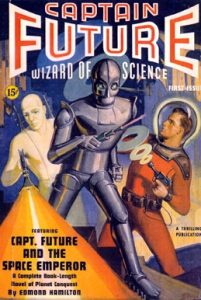 Or so the story goes. In actuality, the Thrilling Group’s editorial staff had been batting around ideas for a science-fictional single-character magazine for about a year, even asking long-time Standard author Edmond Hamilton to work something up involving a “Mr. Future, Wizard of Science.” Eventually, this character evolved into Captain Future, a super-scientist with laboratories and a residence on the Moon. In each issue of the pulp, Hamilton’s Captain and his faithful assistants pretty much would save the solar system from desolation at the hands of this villain or that. The novels were fairly juvenile space-opera. CAPTAIN FUTURE ran until the spring of 1944, surviving for seventeen issues with Edmond Hamilton at the helm for all but one. In 1945-46, three additional Captain Future novels ran in STARTLING STORIES, with Hamilton writing two of them and Manly Wade Wellman one. Seven shorter works followed in 1950, all written by Hamilton. Popular Library reprinted thirteen of the Captain’s adventures in paperback in the late sixties. Today, specialty publisher Haffner Press is collecting the entire series into quality hardbound volumes.
Or so the story goes. In actuality, the Thrilling Group’s editorial staff had been batting around ideas for a science-fictional single-character magazine for about a year, even asking long-time Standard author Edmond Hamilton to work something up involving a “Mr. Future, Wizard of Science.” Eventually, this character evolved into Captain Future, a super-scientist with laboratories and a residence on the Moon. In each issue of the pulp, Hamilton’s Captain and his faithful assistants pretty much would save the solar system from desolation at the hands of this villain or that. The novels were fairly juvenile space-opera. CAPTAIN FUTURE ran until the spring of 1944, surviving for seventeen issues with Edmond Hamilton at the helm for all but one. In 1945-46, three additional Captain Future novels ran in STARTLING STORIES, with Hamilton writing two of them and Manly Wade Wellman one. Seven shorter works followed in 1950, all written by Hamilton. Popular Library reprinted thirteen of the Captain’s adventures in paperback in the late sixties. Today, specialty publisher Haffner Press is collecting the entire series into quality hardbound volumes.
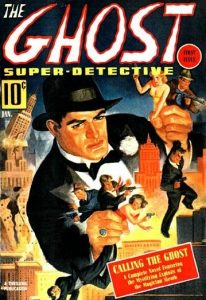 Premiering around the same time as the good captain, THE GHOST, SUPER-DETECTIVE was a short-lived hero pulp that ran for just seven issues, even though, during its abbreviated life, it went through two title changes. It became THE GHOST DETECTIVE in the summer of 1940 and THE GREEN GHOST DETECTIVE in the winter of 1941. Whatever the name, this pulp hero was actually George Chance, a professional magician who decided to use his skills of prestidigitation to fight crime. As The Ghost, Green Ghost, or whatever, Chance took on the guise of a ghoul. As the late Robert Sampson wrote: “His face is bloodless white, the eyes sunk deep in blotched hollows. The nostrils gape wide. Yellow teeth fill a distended mouth. In short, he looks like a dead man, a staring corpse. These features appear by night, glowing with dim luminescence, to the confusion of the underworld.” After the pulp was cancelled in 1941, the character returned in a series of a six short stories that ran in THRILLING MYSTERY from 1942 through 1944. The entire series, both novels and short stories, was written by G. T. Fleming-Roberts. It has been reprinted by The Battered Silicon Dispatch Box as part of its LOST TREASURES FROM THE PULPS library. A prolific author, Fleming-Roberts wrote other single-character adventures including Secret Agent “X,” The Black Hood, Dan Fowler, and Captain Zero. He also penned two other magician-detective series—the Diamondstone tales for POPULAR DETECTIVE and the Jeffery Wren yarns for DIME DETECTIVE.
Premiering around the same time as the good captain, THE GHOST, SUPER-DETECTIVE was a short-lived hero pulp that ran for just seven issues, even though, during its abbreviated life, it went through two title changes. It became THE GHOST DETECTIVE in the summer of 1940 and THE GREEN GHOST DETECTIVE in the winter of 1941. Whatever the name, this pulp hero was actually George Chance, a professional magician who decided to use his skills of prestidigitation to fight crime. As The Ghost, Green Ghost, or whatever, Chance took on the guise of a ghoul. As the late Robert Sampson wrote: “His face is bloodless white, the eyes sunk deep in blotched hollows. The nostrils gape wide. Yellow teeth fill a distended mouth. In short, he looks like a dead man, a staring corpse. These features appear by night, glowing with dim luminescence, to the confusion of the underworld.” After the pulp was cancelled in 1941, the character returned in a series of a six short stories that ran in THRILLING MYSTERY from 1942 through 1944. The entire series, both novels and short stories, was written by G. T. Fleming-Roberts. It has been reprinted by The Battered Silicon Dispatch Box as part of its LOST TREASURES FROM THE PULPS library. A prolific author, Fleming-Roberts wrote other single-character adventures including Secret Agent “X,” The Black Hood, Dan Fowler, and Captain Zero. He also penned two other magician-detective series—the Diamondstone tales for POPULAR DETECTIVE and the Jeffery Wren yarns for DIME DETECTIVE.
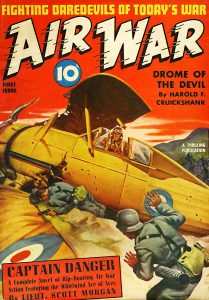 The adventures of Captain Danger were told in AIR WAR, a companion to SKY FIGHTERS, THE LONE EAGLE, and other Thrilling aviation pulps. The magazine debuted during the fall of 1940 and ran for a total of nineteen issues. Credited to Lieutenant Scott Morgan, a house name, the tales of Allen Danger, a soldier of fortune who dedicated his life to helping the downtrodden, appeared in the first fifteen issues of the Standard pulp magazine. Described as a demon of the skies, his missions took him across the globe, delivering aerial justice against the Axis powers. According to pulp historian Don Hutchison, the series was created by Robert Sidney Bowen. However, at least seven of the stories–including the last yarn in the Spring 1944 issue–are known to be the work of Norman Daniels.
The adventures of Captain Danger were told in AIR WAR, a companion to SKY FIGHTERS, THE LONE EAGLE, and other Thrilling aviation pulps. The magazine debuted during the fall of 1940 and ran for a total of nineteen issues. Credited to Lieutenant Scott Morgan, a house name, the tales of Allen Danger, a soldier of fortune who dedicated his life to helping the downtrodden, appeared in the first fifteen issues of the Standard pulp magazine. Described as a demon of the skies, his missions took him across the globe, delivering aerial justice against the Axis powers. According to pulp historian Don Hutchison, the series was created by Robert Sidney Bowen. However, at least seven of the stories–including the last yarn in the Spring 1944 issue–are known to be the work of Norman Daniels.
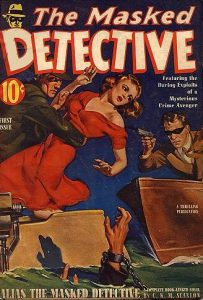 The last of Standard Magazines’ line of non-western single-character pulps, THE MASKED DETECTIVE, also reached newsstands in the fall of 1940. The title character was the alter ego of crime reporter Rex Parker, a laid-back newshawk who worked for a New York newspaper. When not tracking down news for his paper, he battled crime as The Masked Detective. A student of kick-boxing, the detective “wore a neat black suit, gray shirt, dark bow tie, black hat, and a black mask covering his eyes, forehead, and nose. He wore specially built shoes with square, hard toes. He was also a master of ju-jitsu, a good shot, a trained boxer, a makeup artist, and a ventriloquist.” Author credit went to C. K. M. Scanlon, a house name. Norman Daniels is known to have written at least five of the stories. THE MASKED DETECTIVE ran for twelve issues, lasting into the spring of 1943.
The last of Standard Magazines’ line of non-western single-character pulps, THE MASKED DETECTIVE, also reached newsstands in the fall of 1940. The title character was the alter ego of crime reporter Rex Parker, a laid-back newshawk who worked for a New York newspaper. When not tracking down news for his paper, he battled crime as The Masked Detective. A student of kick-boxing, the detective “wore a neat black suit, gray shirt, dark bow tie, black hat, and a black mask covering his eyes, forehead, and nose. He wore specially built shoes with square, hard toes. He was also a master of ju-jitsu, a good shot, a trained boxer, a makeup artist, and a ventriloquist.” Author credit went to C. K. M. Scanlon, a house name. Norman Daniels is known to have written at least five of the stories. THE MASKED DETECTIVE ran for twelve issues, lasting into the spring of 1943.
Scattered throughout Standard’s anthology titles are other so-called pulp heroes including The Crimson Mask. Attributed to Frank Johnson, the series was largely written by the prolific Daniels. The Mask was the alter ego of pharmacist Robert Clarke, a man seeking revenge against the criminals who had murdered his father. Aided by a small group of friends, the Crimson Mask battled gangsters, kidnappers, and Nazi spy rings through sixteen stories. The series ran in Thrilling’s DETECTIVE NOVELS MAGAZINE, debuting in the August 1940 issue and running through the April 1944 number. The Mask’s stories usually alternated with Daniels’ own Candid Camera Kid yarns, introduced in the June 1939 issue. The first five Crimson Mask stories have been reprinted by Altus Press.
 EXCITING DETECTIVE premiered during the fall of 1940, promising “fast-moving, dynamite-packed, up-to-the-minute novels, novelettes, and stories that carry a high-powered punch!” It ran for a total of fifteen issues, ending with its Summer 1943 number, a victim of wartime paper rationing. Appearing in four of its issues–beginning with the Fall 1941 number–was Miles Murdock, a plastic surgeon also known as The Purple Scar. Attributed to John S. Endicott, the stories are thought to be the work of pulp writer George A. McDonald. A “grim nemesis of evil,” The Purple Scar was a master of disguise who spoke in a “hoarse whispering, rather chilling, tomb-like voice.” He wore a purple mask to imitate his murdered brother’s features, scarred by acid and submerged in water. “Purple becomes black at night, which makes my face invisible instead of betraying it as a pale glow in the darkness.” All four of The Scar’s stories have been reprinted by Altus Press.
EXCITING DETECTIVE premiered during the fall of 1940, promising “fast-moving, dynamite-packed, up-to-the-minute novels, novelettes, and stories that carry a high-powered punch!” It ran for a total of fifteen issues, ending with its Summer 1943 number, a victim of wartime paper rationing. Appearing in four of its issues–beginning with the Fall 1941 number–was Miles Murdock, a plastic surgeon also known as The Purple Scar. Attributed to John S. Endicott, the stories are thought to be the work of pulp writer George A. McDonald. A “grim nemesis of evil,” The Purple Scar was a master of disguise who spoke in a “hoarse whispering, rather chilling, tomb-like voice.” He wore a purple mask to imitate his murdered brother’s features, scarred by acid and submerged in water. “Purple becomes black at night, which makes my face invisible instead of betraying it as a pale glow in the darkness.” All four of The Scar’s stories have been reprinted by Altus Press.
Debuting in the May 1941 issue of THRILLING ADVENTURES, Henry Kuttner’s Thunder Jim Wade was a short-lived character who is usually written off as a Doc Savage clone. Published under the house name of Charles Stoddard, Wade was raised in a lost colony of Crete where he developed various mental and physical abilities. A roving troubleshooter operating off of a secret island in the South Pacific, Jim is alerted to problems through agents scattered across the globe. Helped by two assistants–Red Argyle and Dirk Marat–Thunder Jim starred in five adventures published in consecutive issues of the Standard pulp magazine. All have been reprinted in a single volume published by Altus Press, entitled THUNDER JIM WADE: THE COMPLETE SERIES.
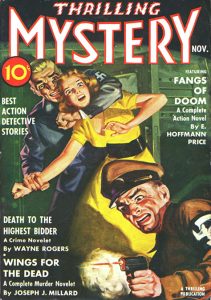 Although the bulk of the Dr. Zeng Tse-Lin stories were co-written by W. T. Ballard and Robert Leslie Bellem and published in POPULAR DETECTIVE, the first story of the series–“Fangs of Doom”–ran in the November 1941 issue of THRILLING MYSTERY. An allegedly Chinese crimefighter who is actually the son of white missionary parents, Zeng was assisted by Lai Hu Chow, a Chinese man who wears an artificial leg in which he can carry weapons and other useful items. The entire series has been reprinted by Altus Press. Dr. Zeng will also be explored during our PulpFest presentation, “Thrilling Detectives,” taking place on Thursday, August 13th, at 8:40 PM.
Although the bulk of the Dr. Zeng Tse-Lin stories were co-written by W. T. Ballard and Robert Leslie Bellem and published in POPULAR DETECTIVE, the first story of the series–“Fangs of Doom”–ran in the November 1941 issue of THRILLING MYSTERY. An allegedly Chinese crimefighter who is actually the son of white missionary parents, Zeng was assisted by Lai Hu Chow, a Chinese man who wears an artificial leg in which he can carry weapons and other useful items. The entire series has been reprinted by Altus Press. Dr. Zeng will also be explored during our PulpFest presentation, “Thrilling Detectives,” taking place on Thursday, August 13th, at 8:40 PM.
As part of its celebration of the Thrilling Group, PulpFest 2015 is proud to welcome Altus Press publisher and 2012 Munsey Award winner Matt Moring; 1979 Lamont Award winner and author of “The Wild Adventures of Doc Savage and Tarzan” Will Murray; pop culture expert and 2014 Inkpot Award winner Michelle Nolan; and popular culture Professor Garyn G. Roberts, who was awarded the Munsey in 2013, for a presentation entitled “Thrilling Heroes of Standard’s Pulps and Comics.” Scheduled for Friday evening, August 14th, at 10:40 PM, it will examine the evolution of the Standard hero in both pulp magazines and comic books. Thrilling’s heroes of the detective and western genres will be dissected on Thursday, August 13th.
Our discussion of Standard’s heroes began on Friday, June 19th, to call attention to this “Thrilling Presentation!!!” You can read our previous post about the Thrilling pulp heroes of the thirties by visiting pulpcon.org. On Sunday, we’ll turn our attention to the comic book heroes of Standard, Better, Nedor, and Visual Editions.
(George Rozen’s painting for the August 1, 1933 issue of THE SHADOW MAGAZINE is perhaps one of the artist’s most iconic images of Walter Gibson’s “Dark Avenger.” Born 110 years ago in October 1895, Rozen and his twin brother, Jerome, were both pulp artists. George’s first published assignments were covers and interior pen-and-ink story illustrations for Fawcett magazines. In 1931, he replaced his brother as the cover artist for Street & Smith’s THE SHADOW MAGAZINE. George Rozen became the pulp’s most renowned cover artist, while his brother branched out into the more prestigious fields of advertising and slick magazines.
As time passed, George Rozen continued to work for the pulp industry, selling cover art to all of the major publishers including Popular and the Thrilling Group. For Ned Pines, Rozen painted adventure, detective (such as the first issue of THE MASKED DETECTIVE, dated Fall 1940), western, war, and even science-fiction covers, including the first issue of CAPTAIN FUTURE, dated January 1940. As the pulp market began to contract, his work was increasingly found on paperbacks from Popular Library and Ace.
While training for the priesthood in his native Puerto Rico, Rafael de Soto began taking private art lessons with a local artist. He emigrated to the United States in 1923 and soon found work at an advertising company. He began to draw interior story illustrations for Street & Smith’s western pulp magazines in 1930. Two years later, he started to sell freelance cover paintings to all the major pulp magazine publishers including Clayton, Dell, Fiction House, Popular, Street & Smith, and the Thrilling Group. It was de Soto who created the cover art for the first issue of THE GHOST SUPER-DETECTIVE, dated January 1940. He continued to produce pulp covers up until the demise of the industry during the 1950s. He also sold freelance illustrations to slick magazines, many paperback book covers, and covers and interior story illustrations for men’s adventure magazines. Rafael de Soto retired from freelance illustration in 1964 and began teaching art at the State University of New York, Farmingdale. He taught art for the rest of his life and embarked on a very successful career as a portrait artist.
Although some have attributed the front cover art for the first issue of AIR WAR, dated Fall 1940, to Harold William McCauley, who primarily worked as a staff artist for the Chicago-based Ziff-Davis publishing house, the painting does not resemble the artist’s usual work. It seems hard to imagine that Standard Publications would launch a new title with an untried free-lance cover artist living in Chicago, who they had never worked with before. Unless proven otherwise, the cover artist for this particular issue of AIR WAR is not known.
Ernest Chiriacka provided the cover illustrations for both the Fall 1940 issue of EXCITING DETECTIVE (featuring the premier of The Purple Scar series) and the November 1941 issue of THRILLING MYSTERY (which featured E. Hoffmann Price’s “Fangs of Doom,” the start of the Dr. Zeng series). Chiriacka’s first published story illustrations appeared in 1939 in Street & Smith’s LOVE STORY MAGAZINE. During the 1940s, he began selling freelance pulp covers to a variety of magazines including ADVENTURE, BLACK BOOK DETECTIVE, DETECTIVE FICTION WEEKLY, DIME WESTERN, G-MEN DETECTIVE, THE PHANTOM DETECTIVE, STAR WESTERN, SWEETHEART STORIES, TEXAS RANGERS, and WESTERN ACES. In 1950, he joined the American Artists Agency and began a successful career as a slick magazine illustrator. He also painted many paperback covers up until 1965. Afterward, he retired from commerical illustration to concentrate on painting visionary landscapes of the Old West.)

